A classic and highly sociopolitically aware Heavy Metal album that marked a musical turn of the band, somewhat lowering their death metal sound and enriching it with prog and tribal elements. More in allmusic
Δευτέρα 31 Μαΐου 2010
Πέμπτη 27 Μαΐου 2010
Victoria Frances, part 2

Victoria Francés (1982-) is a Spanish illustrator. Her work is very goth-inspired: ghostly women in long dresses are perhaps the most common characters found in her art. Unsurprisingly, she cites her influences as Edgar Allan Poe, Anne Rice and H. P. Lovecraft. She also claims to have been influenced by the art of Luis Royo and Brom.
 Influenced by pre-Raphaelite paintings, she chooses subjects that take many people to a symbolic, magical and ancient world. All the sufferings of the outcast of this world is shown in dark castles and mansions with flickering lights, with the distinct influence of Goethe, Edgar Allan Poe, Baudelaire and Bram Stoker.
Influenced by pre-Raphaelite paintings, she chooses subjects that take many people to a symbolic, magical and ancient world. All the sufferings of the outcast of this world is shown in dark castles and mansions with flickering lights, with the distinct influence of Goethe, Edgar Allan Poe, Baudelaire and Bram Stoker. From her early childhood she was fascinated by the beauty of the forest in Galicia, where she spent much of her infancy. After traveling to cities like London and Paris she was hypnotized by the atmosphere there, the same that brought to life legendary masterpieces of Gothic literature. Her illustrations and sketches recall the dreamlike world of Gothic Romanticism.
From her early childhood she was fascinated by the beauty of the forest in Galicia, where she spent much of her infancy. After traveling to cities like London and Paris she was hypnotized by the atmosphere there, the same that brought to life legendary masterpieces of Gothic literature. Her illustrations and sketches recall the dreamlike world of Gothic Romanticism. Visit her site http://www.victoriafrances.es/
Visit her site http://www.victoriafrances.es/
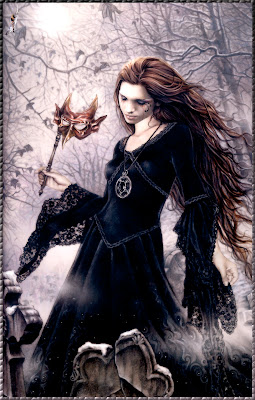






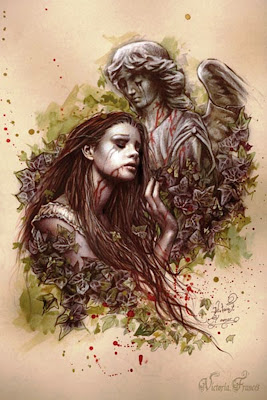
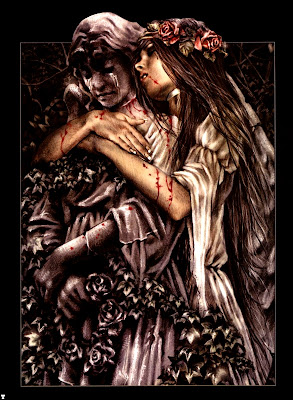
Τρίτη 25 Μαΐου 2010
EP: Surf Nicaragua, Band: Sacred Reich (1988)
A classic EP by this underestimated thrash metal band with sociopolitical interest in lyrics. More in allmusic
Παρασκευή 21 Μαΐου 2010
Compendium Maleficarum by Francesco Maria Guazzo (1608)
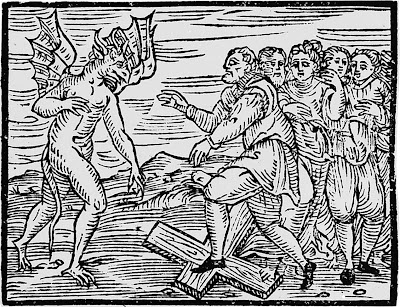 O Francesco Maria Guazzo (15??-16??) ήταν Ιταλός μοναχός από το Μιλάνο, γνωστός για το έργο του "Επιτομή της Μαγείας"(Compendium Maleficarum)(1608). Σε αυτό το βιβλίο είχε συγκεντρώσει όλες τις δοξασίες εκείνης της εποχής, για τη σχέση της μαγείας με τον διάβολο, για τις τελετουργίες της, τρόπους απώθησής τους, για σεξουαλικές σχέσεις ανθρώπων και δαιμόνων, κλπ, κλπ, μέχρι και «συστηματική ταξινόμηση» των «ειδών» των δαιμόνων επιχείρησε να κάνει, βασισμένος σε παλιότερες αναφορές του Μιχαήλ Ψελλού. Βασίστηκε σε πρότερα βιβλία μαγείας και δαιμονολογίας, αλλά μέχρι και σε βιβλίο Φυσικής Ιστορίας του Πλίνιου! Περιέχει και ανεκδοτολογικές εξιστορήσεις δαιμονισμένων, όπως την ιστορία μια κοπέλας που ξερνούσε περίεργα και ύποπτα πράματα όπως τρίχες, ξύλα και γαλόνια αίματος…
O Francesco Maria Guazzo (15??-16??) ήταν Ιταλός μοναχός από το Μιλάνο, γνωστός για το έργο του "Επιτομή της Μαγείας"(Compendium Maleficarum)(1608). Σε αυτό το βιβλίο είχε συγκεντρώσει όλες τις δοξασίες εκείνης της εποχής, για τη σχέση της μαγείας με τον διάβολο, για τις τελετουργίες της, τρόπους απώθησής τους, για σεξουαλικές σχέσεις ανθρώπων και δαιμόνων, κλπ, κλπ, μέχρι και «συστηματική ταξινόμηση» των «ειδών» των δαιμόνων επιχείρησε να κάνει, βασισμένος σε παλιότερες αναφορές του Μιχαήλ Ψελλού. Βασίστηκε σε πρότερα βιβλία μαγείας και δαιμονολογίας, αλλά μέχρι και σε βιβλίο Φυσικής Ιστορίας του Πλίνιου! Περιέχει και ανεκδοτολογικές εξιστορήσεις δαιμονισμένων, όπως την ιστορία μια κοπέλας που ξερνούσε περίεργα και ύποπτα πράματα όπως τρίχες, ξύλα και γαλόνια αίματος… Η ταξινόμηση των δαιμόνων κατά F.M.Guazzo (1608)λοιπόν έχει ως εξής:
Η ταξινόμηση των δαιμόνων κατά F.M.Guazzo (1608)λοιπόν έχει ως εξής:-Δαίμονες των ψηλότερων στρωμάτων της ατμόσφαιρας που δεν συνάπτουν σχέσεις ή επαφές με ανθρώπους.
-Δαίμονες των μεσαίων ατμοσφαιρικών στρωμάτων που είναι υπέυθυνοι για τις καταιγίδες.
-Δαίμονες της Γης που φωλιάζουν σε λιβάδια, σπηλιές και δάση.
-Δαίμονες του νερού που είναι θηλυκοί και εξοντώνουν τα υδρόβια ζώα.
-Δαίμονες του Κάτω Κόσμου που κρύβουν θησαυρούς, προκαλούν σεισμούς και δονήσεις των σπιτιών.
-Δαίμονες της νύχτας που είναι μαύροι και οι πιο κακόβουλοι και φοβούνται το φως της μέρας.
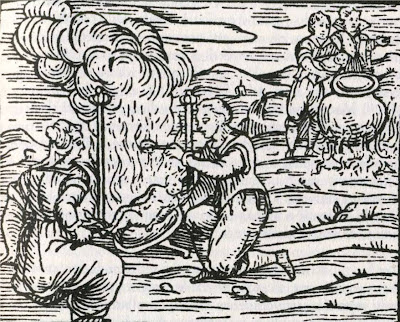 Είναι γεμάτο γκραβούρες με τελετουργίες, ανθρωποθυσίες, συνάξεις με τον διάβολο (Sabbats) και ιερόσυλες αντιχριστιανικές πρακτικές. Aν και είχε περιορισμένη εμβέλεια διάδοσης εκείνη την εποχή, πιστεύεται πως χρησιμοποιήθηκε, μαζί με το γνωστό Maleus Maleficarum, ως στοιχείο δικαιολόγησης και στήριξης των κατηγοριών και του κυνηγιού των μαγισσών το μεσαίωνα, βρίσκοντας ανταπόκριση στην μαζική παράνοια και προκατάληψη εκείνης της εποχής, αφού όλα όσα αναφέρονταν σε τέτοια βιβλία, γραμμένα μάλιστα από ανθρώπους του Θεού, θεωρούνταν πέρα ως πέρα αληθινά. Επανεκδόθηκε και μεταφράστηκε στα αγγλικά από τον Montague Summers το 1929.
Είναι γεμάτο γκραβούρες με τελετουργίες, ανθρωποθυσίες, συνάξεις με τον διάβολο (Sabbats) και ιερόσυλες αντιχριστιανικές πρακτικές. Aν και είχε περιορισμένη εμβέλεια διάδοσης εκείνη την εποχή, πιστεύεται πως χρησιμοποιήθηκε, μαζί με το γνωστό Maleus Maleficarum, ως στοιχείο δικαιολόγησης και στήριξης των κατηγοριών και του κυνηγιού των μαγισσών το μεσαίωνα, βρίσκοντας ανταπόκριση στην μαζική παράνοια και προκατάληψη εκείνης της εποχής, αφού όλα όσα αναφέρονταν σε τέτοια βιβλία, γραμμένα μάλιστα από ανθρώπους του Θεού, θεωρούνταν πέρα ως πέρα αληθινά. Επανεκδόθηκε και μεταφράστηκε στα αγγλικά από τον Montague Summers το 1929. Francesco Maria Guazzo, (15??-16??) was an Italian priest in Milan. He wrote a book, the Compendium Maleficarum), in which he described the eleven formulae or ceremonies previous to the vow to Satan, allegedly necessary to participate of the Sabbath; besides, Guazzo offered detailed descriptions of the sexual relationships between men and incubi/incubus, and women and succubi/succubus, the iniquitous and execrable operations of witches against the human race, and the divine remedies by which they may be frustrated. Guazzo established also a classification of the demons, inspired by a previous work by Michael Psellus:
Francesco Maria Guazzo, (15??-16??) was an Italian priest in Milan. He wrote a book, the Compendium Maleficarum), in which he described the eleven formulae or ceremonies previous to the vow to Satan, allegedly necessary to participate of the Sabbath; besides, Guazzo offered detailed descriptions of the sexual relationships between men and incubi/incubus, and women and succubi/succubus, the iniquitous and execrable operations of witches against the human race, and the divine remedies by which they may be frustrated. Guazzo established also a classification of the demons, inspired by a previous work by Michael Psellus: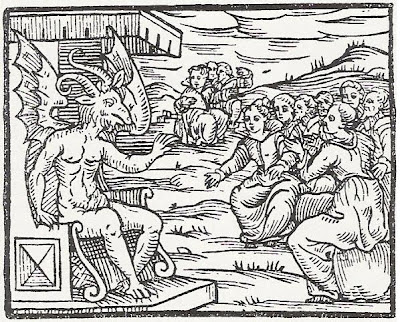 -Demons of the superior layers of the air, which never establish a relationship with people.
-Demons of the superior layers of the air, which never establish a relationship with people.-Demons of the inferior layers of the air, which are responsible for storms.
-Demons of Earth, which dwell in fields, caves and forests.
-Demons of water, which are female demons, and destroy aquatic animals.
-Demons of the underground part of the Earth, responsible of keeping hidden treasures, causing earthquakes, and causing the crumbling of houses.
-Demons of the night, which are black and evil. These demons avoid daylight.

This handbook on witchcraft claims to expose the entire practice and profession of witchcraft. Was used as support in the accusation of witches at the time, although we can recognize much of it today as being paranoid superstition by religious authorities. The book is valuable because it allows one to view the extreme superstition surrounding witchcraft at the time, and to better understand the degree of persecution that resulted.
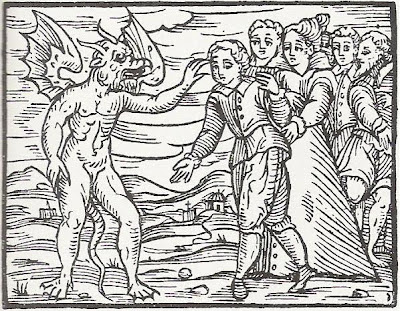 The book is as it says--a compendium of information about witchcraft and how to deal with it. Guazzo borrows not only from other witch manuals (such as the more famous Malleus Maleficarum or Nicholas Remy's Demonolatry), but also from works like Pliny's Natural History. It contains a number of annecdotes collected from other sources, such as the story of a girl who continuously vomits up strange items (hair, wood, gallons of blood...).
The book is as it says--a compendium of information about witchcraft and how to deal with it. Guazzo borrows not only from other witch manuals (such as the more famous Malleus Maleficarum or Nicholas Remy's Demonolatry), but also from works like Pliny's Natural History. It contains a number of annecdotes collected from other sources, such as the story of a girl who continuously vomits up strange items (hair, wood, gallons of blood...). The book was published only three times, in 1608 and again in 1624, after Guazzo's death, and finally when it was translated by Montague Summers in 1929. The real, lasting influence of the book is not the information it contains--again, that can be found in any number of books--but in the woodcuts it contains, which show various details of so-called sabbats.
The book was published only three times, in 1608 and again in 1624, after Guazzo's death, and finally when it was translated by Montague Summers in 1929. The real, lasting influence of the book is not the information it contains--again, that can be found in any number of books--but in the woodcuts it contains, which show various details of so-called sabbats.

Τετάρτη 19 Μαΐου 2010
Théodore Géricault's macabre and insanity paintings
Ο Théodore Géricault (1791–1824) ήταν Γάλλος ρομαντικός ζωγράφος που πέθανε νεότατος, γνωστός για τις απεικονίσεις του αλόγων και ιππέων στρατιωτών, μια και η ιππασία ήταν το χόμπυ του, αλλά κυρίως για το αριστούργημα για το οποίο έμεινε στην ιστορία, το The Raft of the Medusa, σε μια εκδοχή του οποίου, καθώς και για το περιεχόμενό του, έχω ήδη αναφερθεί ξανά ΕΔΩ.
Ηταν ανήσυχο πνεύμα με συχνά ψυχικά προβλήματα κατάθλιψης. Σε αυτή του την ψυχική κατάσταση ίσως να οφείλονται και μερικοί μακάβριοι πίνακές του, καθώς και απεικονίσεις ψυχικά διαταραγμένων ατόμων, θέματα που ίσως τον βοηθούσαν στο να ξεπερνάει τις κρίσεις του. Πέθανε πολύ νέος από επιπλοκές παλιών τραυμάτων από την ιππασία και από χρόνια φλεγμονή σκωληκοειδίτιδας, δυο προβλήματα που τον ταλαιπώρησαν πολύ τα τελευταία χρόνια της ζωής του.
Οι ψυχικές διαταραχές και οι παράλογες καταστάσεις του ανθρώπινου ψυχισμού συχνά έχουν κινήσει το ενδιαφέρον των καλλιτεχνών ενάντια στον ορθολογισμό του Διαφωτισμού. Ο Géricault, όπως πολλοί συγχρονοί του, μελέτησε την επίδραση διαφόρων ψυχικών καταστάσεων (τρέλα, στιγμές θανάτου) στην έκφραση του προσώπου και πίστευε, όπως πολλοί εκείνη την εποχή, ότι το πρόσωπο αποκαλύπτει με μεγάλη ακρίβεια τον χαρακτήρα, ειδικά στην τρέλα. Μελέτησε, λοιπόν, ενδελεχώς έγκλειστους με βαριά περιστατικά σε άσυλα και νοσοκομεία, δίπλα σε πρωτοπόρους ψυχίατρους εκείνη την εποχή, καθώς και κεφάλια αποκεφαλισμένων από γκιλοτίνες ή ανθρώπινα τεμαχισμένα μέλη σε νεκροτομεία. Είναι από τους πρώτους καλλιτέχνες που απεικονίζει την τρέλα και την ψυχική διαταραχή ως ασθένεια και όχι ως θέμα για γέλιο και κοροϊδία.
Théodore Géricault (1791–1824) was a romantic French painter who died very young, known for his paintings of soldiers in cavalry or horses, a beloved for him theme. But his masterpiece was the The Raft of the Medusa, a study of it I have already presented HERE.
He suffered from mental depression and probably this was the motive to deal in some of his paintings with macabre themes like death and mental illnesses. Weakened by riding accidents and chronic tubercular infection, he died in Paris after a long period of suffering.
Mental aberration and irrational states of mind could not fail to interest artists against Enlightenment rationality. Géricault, like many of his contemporaries, examined the influence of mental states on the human face and believed, as others did that a face more accurately revealed character, especially in madness and at the moment of death. He made many studies of the inmates in hospitals and institutions for the criminally insane, and he studied the heads of guillotine victims. He was among the first to depict an abnormal mental state as an illness, rather than as a subject for laughter.
Ετικέτες
art classic-medieval,
Theodore Gericault
Δευτέρα 17 Μαΐου 2010
Παρασκευή 14 Μαΐου 2010
Cannibalism
Ο Κανιβαλισμός ως ετυμολογία προέρχεται από το ισπανικό όνομα της φυλής Καρίμπ της Καραϊβικής, η οποία θεωρούνταν ότι επιδίδονταν στην ανθρωποφαγία, αν και οι αναφορές μάλλον είναι υπερβολικές και προκατειλημμένες για να αφαιρέσουν από τους ιθαγενείς την ανθρώπινη ιδιότητά τους και να τους μεταχειρίζονται σαν ζώα οι άποικοι.
of hunger and pestilential trouble which
happened in such a way in the country of
Reissen and Lithuania in year 1571
Όμως η ανθρωποφαγία ήταν μια πρακτική διαδεδομένη ανά τους αιώνες σε διάφορες φυλές και λαούς, κυρίως για τελετουργικούς σκοπούς, πιθανότατα από την πολύ προϊστορική εποχή. Εικάζεται ότι οι Νεάντερταλ επιδίδονταν σε κανιβαλισμό. Σήμερα περιορίζεται σε τελετουργικό κανιβαλισμό σε λίγες φυλές στα νησιά του Ειρηνικού, όμως υπάρχουν πολλές αναφορές στην Αφρική κατά τη διάρκεια σύγχρονων πολεμικών συρράξεων (Κογκό, Λιβερία, κλπ) ως μέσο ταπείνωσης του εχθρού.

 Reports of cannibalism were also recorded during the First Crusade, as Crusaders fed on the bodies of their dead opponents following the Siege of Ma'arrat al-Numan. It is also possible that the Crusaders staged such incidents as part of psychological warfare. Amin Maalouf also discusses further cannibalism incidents on the march to Jerusalem, and to the efforts made to delete mention of these from western history.(13th century)
Reports of cannibalism were also recorded during the First Crusade, as Crusaders fed on the bodies of their dead opponents following the Siege of Ma'arrat al-Numan. It is also possible that the Crusaders staged such incidents as part of psychological warfare. Amin Maalouf also discusses further cannibalism incidents on the march to Jerusalem, and to the efforts made to delete mention of these from western history.(13th century)Επίσης σε περιπτώσεις λιμού, ακόμα και πολιτισμένοι έχουν επιδοθεί στην ανθρωποφαγία νεκρών για να επιβιώσουν. Επίσης διανοητικά διαταραγμένα άτομα νοιώθουν παρόρμηση να τραφούν με ανθρώπινο κρέας.
Στις φωτό βλέπουμε καλλιτεχνικές αναπαραστάσεις ανθρωποφαγίας σε διάφορες περιστασεις, από τελετουργίες σε διάφορες φυλές, από λιμό, από ταπεινώσεις αιχμαλώτων και νεκρών σε πολεμικές περιόδους, καθώς και αναφορές από πιο σύγχρονα περιστατικά λόγω λιμού ή εγκληματικών ενεργειών
Cannibalism (from Caníbalis, the Spanish name for the Carib people, a West Indies tribe well known for their practice of cannibalism). Cannibalism has recently been both practised and fiercely condemned in several wars, especially in Liberia and Congo. Today, the Korowai are one of very few tribes still believed to eat human flesh as a cultural practice. It is also still known to be practised as a ritual and in war in various Melanesian tribes. Historically, allegations of cannibalism were used by the colonial powers to justify the enslavement of what were seen as primitive peoples.
Cannibalism was widespread in the past among humans throughout the world, continuing into the 19th century in some isolated South Pacific cultures. Neanderthals are believed to have practised cannibalism, and they may have been cannibalized by modern humans.
 Cannibalism on the Raft of the Medusa
Cannibalism on the Raft of the MedusaTheodore Gericault (1818-1819)
a study of the famous painting that depicts a moment of the survivors on a raft from the wreck of the French naval frigate Méduse on July 5, 1816. At least 147 people were set adrift on a hurriedly constructed raft; all but 15 died in the 13 days before their rescue, and those who survived endured starvation, dehydration, cannibalism, dehumanization and madness.
Cannibalism has been occasionally practised as a last resort by people suffering from famine, occasionally it has occurred in modern times. A famous example is the crash of Uruguayan Air Force Flight 571, after which some survivors ate the bodies of deceased passengers. Also, some mentally ill individuals obsess about eating others and cannibalize.
 Survivors of the Uruguayan Air Force Flight 571 (1972)
Survivors of the Uruguayan Air Force Flight 571 (1972)Uruguayan Air Force Flight 571 crashed in the Andes at 3.600 m. altitude on October 13, 1972. The last of the 16 survivors were rescued on December 23, 1972. Faced with starvation and radio news reports that the search for them had been abandoned, the survivors fed on the dead passengers who had been preserved in the snow. Rescuers did not learn of the survivors until 72 days after the crash when two passengers, after a 12-day trek across the Andes, found help.
(wikipedia)
Ετικέτες
art classic-medieval,
customs,
history,
Theodore Gericault
Πέμπτη 13 Μαΐου 2010
Hans Staden's and Theodore de Bry's tribal canibalism illustrations
O Hans Staden (1525-1579) ήταν Γερμανός στρατιώτης και ναυτικός που ταξίδεψε με Πορτογαλικές αποστολές στη Νότια Αμερική. Στο δεύτερο ταξίδι του, κατά τη διάρκεια κυνηγιού, συνελήφθη από πολεμιστές της φυλής των Tupinambá και κρατήθηκε αρκετό καιρό αιχμάλωτος. Ισχυρίστηκε ότι τα μέλη της ήταν ανθρωποφάγα, που έτρωγαν σε τελετουργικά γεύματα τους αιχμαλώτους τους. Ηταν και αυτός υποψήφιος για να γίνει γεύμα, αλλά έκανε μια εξυπηρέτηση στον αρχηγό της φυλής θεραπεύοντάς τον από μια αρρώστια και έτσι την γλύτωσε. Λέγεται ότι του έδωσαν να δοκιμάσει μια σούπα, από ένα καζάνι που στον πάτο είχε δυο μικρά κρανία τα οποία ήταν από παιδιά της χορωδίας του! Αφού απέτυχαν οι διαπραγματεύσεις των Πορτογάλων με τους Tupinambá για απελευθέρωσή του, τελικά δραπετεύει και το 1555 επιστρέφει στην Ευρώπη όπου γράφει και εκδίδει σε βιβλίο τις εμπειρίες του το 1557. Το δε εικονογραφημένο κεφάλαιο με τις γλαφυρές και λεπτομερείς περιγραφές των κανιβαλικών συνηθειών των Tupinambá αποτέλεσε και τον κυριότερο λόγο της τεράστιας επιτυχίας αυτού του βιβλίου. Αν και πολλοί αμφισβήτησαν την αλήθεια των περιγραφών του, ακόμα κάποιοι το χρησιμοποιούν ως έγκυρη και αξιόπιστη εθνογραφική αναφορά.
Αν και αυτό είναι το πιο περιγραφικό βιβλίο για τον κανιβαλισμό, αυτό που έχει τις πιο σοκαριστικές εικόνες είναι το βιβλίο του Theodore de Bry (1528–1598) που αναφέρεται στις επισκέψεις διαφόρων αποίκων στην νεοανακαλυφθείσα Αμερική.
Hans Staden (1525-1579) was a German soldier and mariner who voyaged to South America. On one voyage, he was captured by the Tupinambá people of Brazil whom he claimed practiced cannibalism. He wrote a widely read book describing his experiences.
During his second trip to South America, while engaged in a hunting expedition, he was captured by a party belonging to the Tupinambá people of Brazil. They carried him to their village where he claimed he was to be devoured at the next festivity. He allegedly won the friendship of a powerful chief, whom he cured of a disease, and his life was spared. The Portuguese tried several times to negotiate for Staden's ransom, but the Indians declined all overtures. At last he made his escape on a French ship, and on 22 February 1555, arrived at Honfleur, in Normandy, and from there went immediately to his native city.
After his return to Europe, he published an account of his captivity, entitled Warhaftige Historia und beschreibung eyner Landtschafft der Wilden Nacketen, Grimmigen Menschfresser-Leuthen in der Newenwelt America gelegen (True Story and Description of a Country of Wild, Naked, Grim, Man-eating People in the New World, America) (1557). The book became an international bestseller.
The Warhaftige Historia provided detailed descriptions of Tupinambá life and customs, illustrated by woodcuts. However, the aspect of the book that received the most attention, from the time of publication up to the present, was cannibalism. Staden claimed that the Tupinambá were cannibals, gave vivid eyewitness accounts of the killing, preparing and eating of war captives. According to one anecdote, the Indians at one point gave him a delicious soup; after finishing his dinner, he found in the bottom of the cauldron some small skulls, which he later found out to be those of the children in his choir.
Some scholars have challenged the book's reliability, arguing that Staden invented its sensational accounts of cannibalism. Others defend the book as an important and reliable ethnohistorical source. (wikipedia)
But the most creepy illustrations of tribal cannibalism in Latin America when discovered, was those by Theodore de Bry (1528–1598) in his book about the colonisation of America by various colonists) .
Ετικέτες
book illustrations,
customs,
Hans Staden,
Theodore de Bry
Εγγραφή σε:
Αναρτήσεις (Atom)



















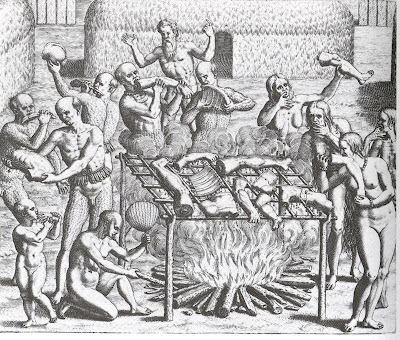















.jpg)



